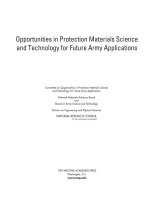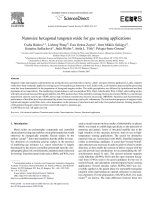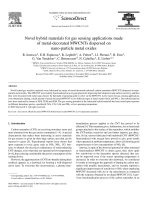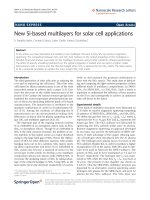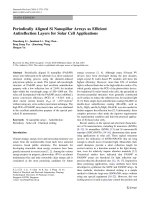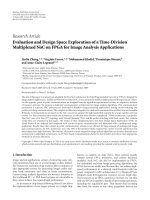Biomass sugars for non fuel applications
Bạn đang xem bản rút gọn của tài liệu. Xem và tải ngay bản đầy đủ của tài liệu tại đây (7.02 MB, 280 trang )
Biomass Sugars for Non-Fuel Applications
RSC Green Chemistry
Editor-in-Chief:
Professor James Clark, Department of Chemistry, University of York, UK
Series Editors:
Professor George A. Kraus, Department of Chemistry, Iowa State University,
Ames, Iowa, USA
Professor Andrzej Stankiewicz, Delft University of Technology, The Netherlands
Professor Peter Siedl, Federal University of Rio de Janeiro, Brazil
Titles in the Series:
1:
2:
3:
4:
5:
6:
7:
8:
9:
The Future of Glycerol: New Uses of a Versatile Raw Material
Alternative Solvents for Green Chemistry
Eco-Friendly Synthesis of Fine Chemicals
Sustainable Solutions for Modern Economies
Chemical Reactions and Processes under Flow Conditions
Radical Reactions in Aqueous Media
Aqueous Microwave Chemistry
The Future of Glycerol: 2nd Edition
Transportation Biofuels: Novel Pathways for the Production of Ethanol,
Biogas and Biodiesel
10: Alternatives to Conventional Food Processing
11: Green Trends in Insect Control
12: A Handbook of Applied Biopolymer Technology: Synthesis, Degradation
and Applications
13: Challenges in Green Analytical Chemistry
14: Advanced Oil Crop Biorefineries
15: Enantioselective Homogeneous Supported Catalysis
16: Natural Polymers Volume 1: Composites
17: Natural Polymers Volume 2: Nanocomposites
18: Integrated Forest Biorefineries
19: Sustainable Preparation of Metal Nanoparticles: Methods and
Applications
20: Alternative Solvents for Green Chemistry: 2nd Edition
21: Natural Product Extraction: Principles and Applications
22: Element Recovery and Sustainability
23: Green Materials for Sustainable Water Remediation and Treatment
24: The Economic Utilisation of Food Co-Products
25: Biomass for Sustainable Applications: Pollution Remediation and Energy
26: From C-H to C-C Bonds: Cross-Dehydrogenative-Coupling
27: Renewable Resources for Biorefineries
28: Transition Metal Catalysis in Aerobic Alcohol Oxidation
29: Green Materials from Plant Oils
30: Polyhydroxyalkanoates (PHAs) Based Blends, Composites and
Nanocomposites
31: Ball Milling Towards Green Synthesis: Applications, Projects, Challenges
32: Porous Carbon Materials from Sustainable Precursors
33: Heterogeneous Catalysis for Today’s Challenges: Synthesis,
Characterization and Applications
34: Chemical Biotechnology and Bioengineering
35: Microwave-Assisted Polymerization
36: Ionic Liquids in the Biorefinery Concept: Challenges and Perspectives
37: Starch-based Blends, Composites and Nanocomposites
38: Sustainable Catalysis: With Non-endangered Metals, Part 1
39: Sustainable Catalysis: With Non-endangered Metals, Part 2
40: Sustainable Catalysis: Without Metals or Other Endangered
Elements, Part 1
41: Sustainable Catalysis: Without Metals or Other Endangered
Elements, Part 2
42: Green Photo-active Nanomaterials: Sustainable Energy and
Environmental Remediation
43: Commercializing Biobased Products: Opportunities, Challenges,
Benefits, and Risks
44: Biomass Sugars for Non-Fuel Applications
How to obtain future titles on publication:
A standing order plan is available for this series. A standing order will bring
delivery of each new volume immediately on publication.
For further information please contact:
Book Sales Department, Royal Society of Chemistry, Thomas Graham House,
Science Park, Milton Road, Cambridge, CB4 0WF, UK
Telephone: þ44 (0)1223 420066, Fax: þ44 (0)1223 420247
Email:
Visit our website at www.rsc.org/books
Biomass Sugars for Non-Fuel
Applications
Edited by
Dmitry Murzin
Abo Akademi University, Turku, Finland
Email:
Olga Simakova
Georgia Institute of Technology, Atlanta, GA, USA
Current address: Amgen Manufacturing, Juncos, PR, USA
Email:
RSC Green Chemistry No. 44
Print ISBN: 978-1-78262-113-3
PDF eISBN: 978-1-78262-207-9
ISSN: 1757-7039
A catalogue record for this book is available from the British Library
r The Royal Society of Chemistry 2016
All rights reserved
Apart from fair dealing for the purposes of research for non-commercial purposes or for
private study, criticism or review, as permitted under the Copyright, Designs and Patents
Act 1988 and the Copyright and Related Rights Regulations 2003, this publication may not
be reproduced, stored or transmitted, in any form or by any means, without the prior
permission in writing of The Royal Society of Chemistry or the copyright owner, or in the
case of reproduction in accordance with the terms of licences issued by the Copyright
Licensing Agency in the UK, or in accordance with the terms of the licences issued by the
appropriate Reproduction Rights Organization outside the UK. Enquiries concerning
reproduction outside the terms stated here should be sent to The Royal Society of
Chemistry at the address printed on this page.
The RSC is not responsible for individual opinions expressed in this work.
The authors have sought to locate owners of all reproduced material not in their own
possession and trust that no copyrights have been inadvertently infringed.
Published by The Royal Society of Chemistry,
Thomas Graham House, Science Park, Milton Road,
Cambridge CB4 0WF, UK
Registered Charity Number 207890
For further information see our web site at www.rsc.org
Printed in the United Kingdom by CPI Group (UK) Ltd, Croydon, CR0 4YY, UK
Preface
The search for a sustainable source of chemicals as alternatives to petroleum
has led to the discovery of multiple routes for renewable biomass conversion
into biofuels and value-added platform chemicals. Extensive research in this
area has been focused primarily on the diversification of energy resources.
In fact, the amount of biomass available currently is too limited to address
all the demands with respect to fuels. Thus ca. 30% of the global arable land
is needed to cover only 10% of the global fuel demand by 2030. It should be
noted that currently the majority of oil is used for the production of fuels,
while only 5–8% (5.8 in 2012) of a crude oil barrel is used in the manufacture
of chemicals, while the turnover in monetary value is almost the same for
fuels and chemicals.
Since the price of fuels is much lower than for chemicals, in the future,
limited resources should be used mainly for chemicals, while the growing
energy demand must be compensated for by alternative energy sources
(solar, hydropower, nuclear, etc.).
The major components of lignocellulosic biomass are cellulose (40–50%),
lignin (16–33%) and hemicelluloses (15–30%), where the last two are practically built up of sugar units. Therefore, biomass is a rich feedstock for the
various sugars and their derivatives.
Sugar derivatives were considered as the top twelve value-added chemicals
from biomass by the U.S. Department of Energy (2004). Extensive research
was performed to advance the technology of cellulosic biomass transformation into biofuels. However, sugar-based chemicals are also a green and
feasible source for the sustainable manufacturing of a variety of valuable
products including polymers, surfactants, pharmaceuticals, and others.
The objective of this book is to represent the scope of green sugar-based
technologies beyond fuels. The book gives an overview of the current status
of sugar-based technology describing the challenges and opportunities with
RSC Green Chemistry No. 44
Biomass Sugars for Non-Fuel Applications
Edited by Dmitry Murzin and Olga Simakova
r The Royal Society of Chemistry 2016
Published by the Royal Society of Chemistry, www.rsc.org
vii
viii
Preface
the synthesis of valuable chemical commodities. Such synthesis starts with
the so-called biorefinery concept, which would allow the production of
chemicals (and fuels) in the same way as it is done nowadays in classical
refineries and large (petro)chemical complexes.
One of the challenges in the valorization of lignocellulosic cellulose is
related to the primary fractionation. This is addressed in the chapter of Seidl
and co-authors. The same authors also describe the Brazilian sugar cane
industry, which is of high importance for making fuels and has a strong
potential for the synthesis of chemicals. The history and current status of
Brazilian sugar cane transformation into chemicals are presented as a real
life case study.
The work of Fardim and co-workers focuses on hemicelluloses, in particular xylans, which are now the most studied hemicelluloses. The most
effective extraction methods, as well as potential applications of xylan-based
materials for fibre-surface engineering, are presented and discussed.
Leino and co-workers describe the application of oligosaccharides as
pharmaceuticals, while recent advances in the synthesis of sugar-based
surfactants are considered by Kovensky and Grand.
The chapter of Bhaumik and Dhepe gives a comprehensive overview of
multiple strategies to design and develop various catalysts and catalytic
processes to hydrolyse saccharides (cellulose, hemicelluloses) into sugars.
Further catalytic transformations of sugars, namely hydrogenation to
sugar alcohols and aqueous-phase reforming of sugar derivatives, are overviewed respectively by Murzin et al. and Seshan and co-workers.
The editors hope that this book will be helpful to scientists working for
academia and industry, who are primarily focused on the development of
non-fuel applications of sugars.
Contents
Chapter 1 Conversion of Biomass into Sugars
Prasenjit Bhaumik and Paresh Laxmikant Dhepe
1.1
Chapter 2
1
Introduction
1.1.1 Potential Source of Sugars
1.1.2 Applications of Sugars
1.2 Biomass Pre-treatment
1.2.1 Physical Treatment
1.2.2 Physico–Chemical Treatment
1.2.3 Chemical Treatment
1.3 Synthesis of C6 Sugars
1.3.1 Use of a Homogeneous Catalytic System
1.3.2 Use of a Heterogeneous Catalytic System
1.4 Synthesis of C5 Sugars
1.4.1 Use of a Homogeneous Catalytic System
1.4.2 Use of a Heterogeneous Catalytic System
1.5 Synthesis of Sugars via an Isomerization Reaction
1.6 Conclusions and Outlook
References
1
4
6
6
8
9
10
13
15
22
33
35
36
40
43
46
Aqueous-phase Reforming of Sugar Derivatives: Challenges
and Opportunities
T. M. C. Hoang, A. K. K. Vikla and K. Seshan
54
2.1
2.2
Aqueous Phase Reforming (APR) Definition
Phase Diagram—Water
RSC Green Chemistry No. 44
Biomass Sugars for Non-Fuel Applications
Edited by Dmitry Murzin and Olga Simakova
r The Royal Society of Chemistry 2016
Published by the Royal Society of Chemistry, www.rsc.org
ix
54
55
x
Contents
2.3
Background—Hydrogen, Steam Reforming and
Water Gas Shift
2.3.1 Current status
2.3.2 Reaction Mechanism for Steam Reforming
of Methane and Higher Hydrocarbons
2.4 Steam Reforming/Gasification of Solid Biomass
2.5 APR of Biomass Streams
2.5.1 APR of Waste Streams to Feedback
Hydrogen
2.5.2 Evaluation of This Concept in Terms of
Hydrogen Economics
2.6 Thermodynamics of APR
2.7 Why Hydrogen is Favoured at APR Conditions
2.8 Mechanism of APR/Reaction Routes
2.9 Definitions/Calculations for Laboratory
Experiments
2.9.1 Carbon to Gas Conversion
2.9.2 Gas Phase Selectivities
2.10 Current Status and Challenges for APR
2.11 APR for Green Chemicals
2.12 Challenges for the Future
Acknowledgements
References
Chapter 3 Catalytic Hydrogenation of Sugars
Dmitry Yu Murzin, Angela Duque, Kalle Arve, Victor Sifontes,
ănen and Tapio Salmi
Atte Aho, Kari Era
3.1
3.2
3.3
3.4
3.5
3.6
3.7
Introduction
Glucose to Sorbitol Hydrogenation
3.2.1 Catalyst Screening
3.2.2 Engineering Aspects
Galactose Hydrogenation
3.3.1 Engineering Aspects
Maltose Hydrogenation
3.4.1 Catalyst Screening
3.4.2 Engineering Aspects
Lactose to Lactitol Hydrogenation
Sucrose or Fructose to D-Mannitol and D-Sorbitol
Hydrogenation
Hydrogenation of Xylose to Xylitol
3.7.1 Catalyst Screening
3.7.2 Engineering Aspects
55
55
59
61
62
63
66
68
68
70
71
71
72
72
80
83
84
84
89
89
94
94
97
103
103
108
108
108
112
118
123
123
126
Contents
xi
3.8 Hydrogenation of Sugar Mixtures
3.9 Final Remarks
References
Chapter 4 Advances in Sugar-based Polymers: Xylan and its
Derivatives for Surface Modification of Pulp Fibres
Beatriz Vega, Olga Grigoray, Jan Gustafsson and
Pedro Fardim
4.1
4.2
4.3
Introduction
Sources and Structures of Xylan
Extraction of Xylan from Biomass and Conversion
to Xylan Derivatives
4.3.1 Extraction of Xylan from Wood Chips
4.3.2 Extraction of Xylan from Chemical
Hardwood Pulp
4.3.3 Xylan Derivatives
4.4 Surface Engineering of Fibres Using Xylan and
Xylan Derivatives
4.4.1 Mechanism of Xylan Adsorption to Cellulose
Fibres
4.4.2 Effect of Xylan Structure and Purity on its
Adsorption
4.4.3 Fibre Engineering with Xylan Sorption in
Bleaching
4.4.4 Xylan Derivatives for Pulp Fibre Modification
4.4.5 Properties of Xylan-modified Fibres
4.5 Conclusions
References
Chapter 5 Recent Advances in the Synthesis of Sugar-based
Surfactants
Jose´ Kovensky and Eric Grand
5.1
5.2
Enzymatic Synthesis of Sugar-based Surfactants
5.1.1 Lipases
5.1.2 Glycosidases
5.1.3 Cyclodextrin Glycosyltransferase
Chemical Synthesis of Sugar-based Surfactants
5.2.1 Chemical Synthesis of Alkyl Glycoses,
Glycosides and Polyglycosides
5.2.2 Chemical Synthesis of Alkyl N-Glycosides
5.2.3 Chemical Synthesis of Alkyl C-Glycosides
127
128
128
134
134
135
137
139
144
145
145
147
147
150
151
153
154
154
159
159
159
163
165
165
165
168
170
xii
Contents
5.2.4
Chemical Synthesis of Non-classical
Structures: Gemini, Bolaform, Dicephalic,
Catanionic
5.2.5 Chemical Synthesis of Functionalized
Sugar-based Surfactants
5.2.6 Polysaccharides
5.3 Surfactants from Microorganisms
5.4 Conclusion and Perspectives
References
Chapter 6 Oligosaccharides for Pharmaceutical Applications
Jani Rahkila, Tiina Saloranta and Reko Leino
6.1
6.2
Introduction
Synthesis
6.2.1 Traditional Synthesis of Oligosaccharides
6.2.2 Automated Synthesis of Oligosaccharides
6.2.3 Isolation and Fractionation of
Polysaccharides from Natural Sources
6.3 Examples of Oligosaccharide Therapeutics on the
Market
6.4 Carbohydrate-based Vaccines and Adjuvants
6.4.1 Pneumococcal Vaccines
6.4.2 b-Mannan Glycoconjugates
6.4.3 Anticancer Vaccines
6.4.4 Adjuvants
6.5 Conclusions
References
Chapter 7 Non-fuel Applications of Sugars in Brazil
˜o Freire and Suzana Borschiver
Peter R. Seidl, Esteva
7.1
7.2
7.3
Introduction
The Sugar Cane Industry in the Brazilian Economy
7.2.1 The Sucrose Platform
7.2.2 Chemicals from Ethanol
The Bioethanol Plant as an Integrated Biorefinery
7.3.1 Treatment of LC Biomass
7.3.2 Pretreatment Processes
7.3.3 Recalcitrance of Lignocellulosic Materials
7.3.4 Enzymatic Treatment of LC Biomass
7.3.5 Complementary Sources of LC Biomass
174
182
197
197
197
199
205
205
206
206
207
210
213
216
218
218
220
221
224
224
228
228
229
230
231
233
234
240
245
246
248
Contents
xiii
7.4
Platform Chemicals from Lignocellulosic Materials
7.4.1 Furans
7.4.2 Organic Acids
7.4.3 Sugar Alcohols
7.5 Prospects for Chemicals from Brazilian Sugar Cane
7.6 A Strategy for Biobased Products
Acknowledgements
References
Subject Index
249
249
251
251
251
254
255
255
258
CHAPTER 1
Conversion of Biomass into
Sugars
PRASENJIT BHAUMIK AND PARESH LAXMIKANT DHEPE*
Catalysis & Inorganic Chemistry Division, CSIR-National Chemical
Laboratory, Dr Homi Bhabha Road, Pune 411008, India
*Email:
1.1 Introduction
In the current circumstances, fossil feedstocks (crude oil, coal and natural
gas) are utilized for the synthesis of a range of chemicals and fuels. Yet, their
sustainability is at stake due to finite reserves, sporadic prices, volatile
geopolitical scenarios and unfavourable effects on the environment (global
warming) because of the discharge of a major contributor to the greenhouse
gas effect, carbon dioxide (CO2) into the atmosphere.1 During World Wars I
and II, due to a shortage of crude oil, Germany and a few other countries
started extensive research on the production of chemicals and fuels (particularly ethanol and diesel) from alternate sources such as coal and bioăr sulfite ethanol
mass.2 The worlds first ethanol production plant (Skutska
plant), based on the sulfite process, was started in 1909 in Sweden.3 Although a total of 33 plants were started using the same concept in Sweden,
since 1983, just one plant has remained operational.3 After the development
of efficient ways throughout the 20th century to explore, extract and process
crude oil, research on biomass was decreased. But, following the recent
crisis in oil production and for geo-political reasons, there has been a
renewed interest in looking for alternative sources for the synthesis of
chemicals and fuels. Though, for a long time, Brazil has successfully shown
RSC Green Chemistry No. 44
Biomass Sugars for Non-Fuel Applications
Edited by Dmitry Murzin and Olga Simakova
r The Royal Society of Chemistry 2016
Published by the Royal Society of Chemistry, www.rsc.org
1
2
Chapter 1
that due to the highest world production of sugarcane (Brazil: 3.3Â108–
7.7Â108 ton per year in 2000–2013, World: 1.3Â109–1.9Â109 ton per year in
2000–2013),4 it can produce bio-ethanol from bagasse (sugarcane waste after
extracting sugar juice) in large quantities for public distribution to run vehicles.5 Conversely, in the rest of the world, after numerous deliberations
and considering history, recently, it has been suggested that the only alternative and sustainable resource, biomass should be leveraged for the synthesis of chemicals and fuels by developing environmentally benign
pathways. Since biomass is renewable, carbon neutral, abundant, locally
accessible in most countries and has a lower impact on the environment, it
becomes a natural choice as an alternate resource.1,6 In recent times, several
countries and industries have disclosed their interests in developing methods for the conversion of biomass into known and new chemicals and fuels.1
Biomass is a non-fossil and is made up of complex molecules present in
plants and animals. It is considered as a rich source of organic products,
which have a characteristic chemical composition of C, H, O, N.7 However,
until now, much of the work has reported on the conversion of plant-derived
biomass into chemicals. Naturally, plant biomass is produced during the
photosynthesis pathway using water, carbon dioxide and sunlight and is
classified into two categories, namely edible and non-edible, solely based on
human consumption ability. For example wheat, rice, corn, potato etc. are
made up of a polysaccharide, starch and are considered as edible biomass or
a first generation raw material (for the synthesis of fuels and chemicals).
Starch is composed of a mixture of linear polysaccharide, amylose (homopolymer of D-glucose linked via a a-1,4 glycosidic bond) and branched
polysaccharide, amylopectin (homopolymer of D-glucose linked via a linear
a-1,4 glycosidic bond and branched a-1,6 glycosidic bond). Non-edible biomass, for example crop waste or wood, is called lignocellulosic biomass or
lignocelluloses and is considered as a second generation raw material.
Lignocelluloses have a composition of ca. 45% cellulose (homopolymer or
homopolysaccharide of D-glucose linked via a b-1,4 glycosidic bond), ca.
25% hemicellulose (heteropolymer or heteropolysaccharide of several C5
and C6 sugars linked via various bonds), ca. 20% lignin (amorphous 3D
network polymer of several aromatic monomers), some macro and micro
nutrients (nitrogen, phosphorus, potassium, calcium, magnesium, sulfur,
iron, manganese, copper, boron, zinc, chloride and molybdenum) and
extractives (fats, fatty acids, resins, tannins, volatile oils, proteins etc.).7,8
Typically, saccharides or carbohydrates (hydrates of carbon) have a molecular formula of Cm(H2O)n, where m and n are almost same. For instance,
a simple monosaccharide, glucose has a molecular formula of C6H12O6
while deoxyribose has a molecular formula of C5H10O4. This makes saccharides rich in oxygen content with an O/C ratio of ca. 1 and a H/C ratio of
2. Usually, during the formation of disaccharides or polysaccharides for
example cellobiose (glucose dimer or disaccharide) with a molecular weight
of 342 and cellulose (glucose polysaccharide) with per unit of glucose
molecular weight of 162, loss of one mole of water (H2O) with a molecular
Conversion of Biomass into Sugars
3
formula of 18 per two moles of monosaccharides is essential. Hence, the
O/C ratio in cellulose and hemicellulose (lignocelluloses) has a slightly
lower value (ca. 0.8).8 Nevertheless, for a chemical to be used as a fuel or fuel
additive, its O/C ratio should be low (biodiesel: ca. 0.1, ethanol: 0.5).8
Consequently, conversions of saccharides into fuels or fuel additive necessitates extra processing for the reduction in O/C ratio. At the same time,
conversions of saccharides into chemicals (sugars and its derivatives) for
non-fuel applications exempt the extra process of decreasing the O/C ratio.
Hence, it is apparent that lignocelluloses should be used for chemical
production. Moreover, economic analysis suggests that while lignocelluloses are obtainable at a price of $50 per ton, glucose has a market
price of $450–650 per ton and xylose has a market price of $1000–2500 per
ton.9 Further conversion of these monosaccharides (sugars) into various
chemicals such as 5-hydroxymethylfurfural (HMF) ($300 000–350 000 per
ton), furfural ($2500–3000 per ton), sorbitol ($500–700 per ton) and xylitol
($1000–3000 per ton) adds value to these sugars.9 Hence, it is understandable that suitable transformations of starch, cellulose and hemicellulose to
various sugars (C6 and C5) via hydrolysis of glycosidic bonds present in
polysaccharides are economical. Nevertheless, use of a first generation
biomass (polysaccharide), starch for obtaining sugars as platform chemicals to produce a variety of other essential chemicals is a debatable
issue since it is principally used as a food. Hence, use of a second generation biomass, lignocelluloses (non-edible biomass)—with a high energy
content (ca. 2Â1010 J per ton of dry biomass)10 is desirable for the synthesis
of sugars. Additionally, huge worldwide availability (1.8Â1012 tones) of
plant-derived lignocelluloses including crop (agricultural) wastes and forest
residues (90–95% with respect to total plant biomass production)8 might
permit those to be used as a feedstock for better rural economy. On the
other hand, in an ideal scenario, it can be considered that from non-edible
feedstock, one can produce edible products (sugars). The conversion of di/
polysaccharides into chemicals can be done by either thermal (combustion,
pyrolysis, gasification, supercritical water), thermo-chemical (acid, alkali) or
biological (enzyme) methods. Under thermal conditions, substrates are
heated at high temperatures (pyrolysis: 4350 1C; gasification: 4550 1C,
supercritical water: B300–400 1C) essentially without a catalyst (however,
in a few cases such as gasification and treatment in supercritical water,
catalysts are added to drive the reaction in a particular direction) to yield
sugars, tar, char, gases etc. In most of these studies, gases (CO, CO2, H2, CH4
etc.) are formed as the main products with a minor quantity of sugars
formed (o20–30%). On the contrary, under thermo-chemical conditions
at lower temperatures (o250 1C), catalysts are used to obtain sugars in
higher quantities by subjecting substrates to hydrolysis. Considering
this, in this chapter, discussions are focused on the conversion of di/
polysaccharides into sugars by hydrolysis reactions. In the conversion of
lignocelluloses to chemicals, multiple steps are involved and these are depicted in Figure 1.1.
4
Chapter 1
Transportation to
Conversion Site
Biomass
Cleaning &
Shredding
Pre-treatment: Physical, Chemical
& Physico-chemical (Isolation)
Hydrolysis
Sugars
Other Chemical
Transformation
Figure 1.1
1.1.1
Fermentation
Illustration of the multiple steps involved in biomass processing to
chemicals.
Potential Source of Sugars
Monosaccharides, or else we call them sugars, are named in two ways: (1) a
monosaccharide containing an aldehyde group is called aldose and (2) a
monosaccharide containing a ketone group is called ketose. In total, eight C6
aldo-sugars (glucose, mannose, galactose, allose, altrose, gulose, idose and
talose) and four C5 aldo-sugars (xylose, arabinose, ribose and lyxose) are
structurally possible. Besides these aldo-sugars, two more keto-sugars viz.
fructose and xylulose are also well-known in nature. But, among them, idose
and talose are not found in nature. Moreover, the presence of allose, altrose,
gulose, ribose and lyxose is very rare in nature and hence discussions on
those are not made here. The rest of the sugars are generally present in
fruits, edible plants, living bodies, bacteria, proteins etc.
In Figure 1.2, likely sources of main C6 sugars (glucose, fructose, mannose, galactose) and C5 sugars (xylose, arabinose, xylulose) are illustrated. In
general, these monosaccharides (sugars) can be obtained by the hydrolysis
(addition of one mole of water per 2 moles of sugars) of their respective
disaccharides [maltose: a-1,4-D-glucose disaccharide (found in potatoes,
cereal, beverages etc.), cellobiose: b-1,4-D-glucose disaccharide, sucrose: disaccharide of a-D-glucose and b-D-fructose linked via a 1,2 glycoside bond
(found in sugarcane, beet, grains etc.), xylobiose: b-1,4-D-xylose disaccharide
etc.]. Further, several polysaccharides such as starch (a-1,4-D-glucose polysaccharide), cellulose (b-1,4-D-glucose polysaccharide), inulin (fructose
polysaccharide), hemicellulose (polysaccharide of several C5 and C6 sugars)
etc. derived from edible and non-edible parts of plant biomass can yield
sugars on hydrolysis. Moreover, lignocelluloses are made up of ca. 75% of
polysaccharides (cellulose, hemicellulose, starch and saccharose)11 and
hence, it will be beneficial to use plant biomass (lignocelluloses) directly for
the synthesis of various sugars. Since cellulose is present as a major component (ca. 45%) in lignocelluloses, its conversion into chemicals (mainly
sugars) is considered as foremost in the bio-refinery concept. In recent
times, municipal solid wastes (kitchen waste containing cellulose) have also
been increasing and their effective utilization to generate chemicals and
Conversion of Biomass into Sugars
Schematic diagram of possible sources of sugars.
5
Figure 1.2
6
Chapter 1
fuels may prove to be vital in curbing the problems of landfill and incineration, which gives rise to pollution by liberating hazardous chemicals and
gases.
1.1.2
Applications of Sugars
Sugars have a variety of applications in fine chemicals, pharmaceuticals,
agriculture, cosmetics etc. In most cases, sugars are used as an energy source
(glucose), low-calorie sweetener (xylose) and for the synthesis of many industrially important chemicals such as furans (5-hydroxymethylfurufral and
furfural; precursors for fuel, resin, plastic, nylon, polyester, fine chemical
etc.), sugar alcohols (sorbitol, mannitol, xylitol, arabitol; used as low-calorie
sweetener, adhesive, cosmetics, energy source etc.), sugar acids (gluconic
acid, xylonic acid, arabinonic acid; used as chelating agent, cement retardant, cosmetics, medicine etc.), acids (succinic acid, itanoic acid, formic acid,
glycolic acid; used in the food industry and polymer industry), alcohols
(ethanol, butanol; used as fuels, solvents etc.) and alkyl ethers of sugars
(alkyl glucoside, alkyl xyloside; used as biomass-derived surfactant etc.)12–14
Because of these extremely significant applications of sugars, it is worth
synthesizing sugars from biomass-derived resources.
1.2 Biomass Pre-treatment
As suggested in Section 1.1.1, the most favourable way to synthesize sugars is
the utilization of lignocellulosic (non-edible) biomass directly as a raw material which consists of polysaccharides (ca. 45% cellulose and ca. 25%
hemicelluloses) in large quantities.8 But, in reality, due to very intricate
hydrogen bonding such as intra-, inter-molecular and inter-sheet in cellulose
(Figure 1.3),15,16 the existence of lignin (aromatic polymer) in lignocelluloses, and multiple bonding between polysaccharides and lignin, it
becomes complicated to process lignocelluloses directly into sugars. During
the conversion of the polysaccharide part (cellulose and hemicellulose) of
lignocelluloses into sugars, lignin remains unconverted because it usually
requires high processing temperatures (4250 1C) compared to polysaccharides (o230 1C).17 And if conversions of lignin are also tried simultaneously
then degradation reactions of sugars become predominant. In most cases,
unconverted lignin is also capable of poisoning the catalytically active sites.
As discussed earlier, due to the occurrence of multiple H-bonding in cellulose, its structure becomes very rigid and crystalline and thus becomes difficult to degrade. A representative XRD pattern for commercially available
microcrystalline cellulose is presented in Figure 1.4. The pattern shows
peaks due to the amorphous (2y ¼ 15.81) and crystalline phases (2y ¼ 22.51,
34.71) of cellulose. Additionally, due to the very strong H-bonding in cellulose, it remains insoluble in many common solvents but is soluble in ionic
liquids (ILs), concentrated aqueous ZnCl2 solution and ammoniacal
Cu(OH)2 solution.18,19 Cellulose also possesses a very high degree of
Conversion of Biomass into Sugars
Figure 1.3
Illustration of the H-bonding present in cellulose.
7
8
Chapter 1
Intensity (a. u.)
22.5
15.8
34.7
5
10
15
20
25
30
2θ
θ
Figure 1.4
35
40
45
50
(o)
Typical XRD pattern of microcrystalline cellulose.
polymerization (DP), for example in wood pulp, it ranges from 300 to 1700
and in cotton and plant fibres, it ranges from 800 to 10 000.20 Because of
these properties of cellulose, its hydrolysis becomes difficult. Furthermore,
the presence of lignin (covering polysaccharides), which has the role of
protecting the polysaccharides from any chemical or biological attacks,
hinders their catalytic conversions. Hence, it becomes indispensable to pretreat the lignocelluloses before hydrolysis for the removal of lignin and to
decrease the crystallinity of cellulose. Other significant aspects in pretreatment are to avoid the degradation or loss of saccharides and make
the overall process economic and environmental friendly. During some of
the pre-treatments, the DP of cellulose decreases, which may increase the
solubility of cellulose (fractions) in water for efficient hydrolysis.
The available biomass pre-treatment methods are classified roughly into
three categories namely: (1) physical (milling, grinding, radiation, ultrasound), (2) physico–chemical (steam explosion, ammonia fiber explosion,
carbon dioxide explosion) and (3) chemical (ozonolysis, alkaline hydrolysis,
oxidative delignification, organic solvent extraction, acid hydrolysis, enzyme
treatment, and ionic liquid treatment).21,22
1.2.1
Physical Treatment
The main purpose of the physical pre-treatment of lignocellulose is to decrease its particle size and cellulose crystallinity. Use of milling and grinding
Conversion of Biomass into Sugars
9
methods can decrease the size of various biomass to 0.2–2 mm from 10–
30 mm.23 The size reduction of lignocellulose is directly related to the energy
consumption and time required for pre-treatment processing. Several reports on the ball milling method show a reduction in size (determined by
particle size analyser), crystallinity (determined by XRD, NMR studies) and
degree of polymerization (DP; determined by anion-exchanged chromatography) in cellulose and hence, increases in its hydrolysis rate.24–26 During
ball milling, an increase in temperature is seen, which has an effect on decrystallization and for this reason, it becomes important to control the
temperatures for reproducible results. Recently, an ultrasound technique
has been used to decrease cellulose crystallinity within a short time in the
presence of water.27 It is shown that Avicel cellulose (particle size ¼ 38 mm)
can be transformed into 0.1–0.6 mm cellulose with a 12.1% decrease in
crystallinity index (without changes in its structure) at 80 1C after subjecting
it to ultrasound treatment (optimum amplitude ¼ 40%) for 3 h. It is assumed
that when cellulose is exposed to ultrasound, which has a higher energy than
the H-bonding energy of cellulose (21 kJ molÀ1), it breaks the H-bonding in
cellulose to form lower crystalline cellulose.28 Microwave irradiation of lignocellulosic biomass causes localized heating of lignocellulose leading to
disruption of the lignocellulose structure29 and since it is a harsh process, it
leads to very high lignin removal from biomass.30,31 However, in terms of
cost and generation of high temperature during treatment, the process is not
efficient on a large scale.32 Additionally, treatment of cellulose with g-rays
leads to the reduction of DP and crystallinity in cellulose but this process
also faces the drawback of high costs.33
1.2.2
Physico–Chemical Treatment
In the widely used steam explosion pre-treatment, biomass is treated with
saturated steam (6.9–48.3 bar) at high temperatures (160–260 1C) and after a
certain time (few seconds to a few minutes), the pressure is suddenly reduced to atmospheric pressure allowing the biomass to undergo explosive
decompression.23,34 This process helps in the removal of hemicellulose and
redistribution of lignin. Various factors such as biomass size, moisture
content, temperature and time are decisive in designing an effective steam
explosion biomass pre-treatment method.35 Moreover, the addition of
mineral acid (H2SO4, CO2; 0.3–3 wt/wt) during steam explosion, improves the
efficiency of the pre-treatment process by decreasing the temperature and
time required.36 The steam explosion treatment has advantages including a
lower energy requirement than mechanical treatment (70% less energy requirement)37 and less environmental impact, which allows the process to
operate on an industrial scale successfully (Iogen Corporation, Canada;
steam explosion using dilute acid pre-hydrolysis of corn stover, barley straw
and bagasse38). Biomass pre-treatment is also carried out in liquid hot water
instead of steam.39 This process can be done in three types of reactors
namely co-current, counter-current and flow-through. In a typical procedure,
10
Chapter 1
all the reactors are maintained at desired temperatures (200–230 1C) for a
specific time (ca. 0.25 h) to achieve efficient pre-treatment.
Ammonia fibre/freeze explosion (AFEX) is another process for lignocellulose pre-treatment where liquid NH3 is in contact with biomass
(typically in a biomass–NH3 ratio of 1 : 1 to 1 : 2) at moderate temperatures
(60–100 1C) and high pressures (17–21 bar) for a specific time and subsequently pressure is reduced to make an explosion.21,40 This process is
reported to be effective for lignocelluloses with a low lignin content (bagasse:
15%, bermudagrass: 5% etc.) rather than a high lignin content (nutshell: 30–
40%, wood: 18–35%, aspen chips: 25% etc.).41
To surmount the problems with high temperature (steam explosion) and
high cost (AFEX) associated with these methods, a carbon dioxide explosion
pre-treatment, which uses carbon dioxide in a supercritical state (Pc ¼ 73.8
bar, Tc ¼ 31.1 1C), has been developed.21,42 Moreover, due to the liquid–
gaseous state of carbon dioxide under supercritical conditions, it has a lower
viscosity and higher diffusivity (than water) and hence, it can easily penetrate
inside the architecture of biomass and separate cellulose and hemicelluloses
from each other and lignin. This process reduces the prospects of degradation product formation from saccharides because of lower operating
temperatures.
1.2.3
Chemical Treatment
Effective lignin removal from lignocellulose can be carried out using ozone
treatment to biomass at room temperature and atmospheric pressure (ozonolysis).43,44 This treatment has a minor effect on the hemicellulose part and
no effect on the cellulose part of lignocelluloses. Moreover, during this
processing, no toxic chemicals are generated. From an environmental point
of view, this process is better since the used ozone can easily be catalytically
decomposed at increased temperatures.45 However, the requirement of a
large amount of costly ozone makes the process expensive.
Another way to remove the lignin part is to use alkali at low temperature
and pressure (alkaline hydrolysis).34,46 During this process, in the presence
of alkaline reagents such as NaOH, KOH, Ca(OH)2, NH4OH, removal of acetyl
and uronic acid substitution in the hemicellulose part is also possible along
with removal of lignin.47–49 The treatment of lignocelluloses with alkali
mainly hydrolyses the intermolecular ester bonds between lignin and polysaccharides to remove lignin leaving behind the free polysaccharides (cellulose, hemicellulose).23 Use of air/oxygen during alkaline hydrolysis
significantly improves the delignification process of biomass with high lignin contents.47 Nonetheless, the chances of polysaccharides undergoing
hydrolysis and oxidation reactions under alkaline conditions make this
process vulnerable.
Delignification of biomass can as well be carried out using H2O2 as an
oxidising agent.46 This process involves removal of both lignin and hemicellulose at a higher extent from lignocellulose. In this method, oxidising
Conversion of Biomass into Sugars
11
chemicals react strongly with the aromatic rings of lignin and generate
aromatic carboxylic acids that can act as inhibitors in the later stages of
transformations, hence they need to be removed or neutralized before processing the celluloses.50
The organosolv process can also remove lignin from biomass. In this
method, several organic solvents (methanol, ethanol, acetone, ethylene glycol, triethylene glycol, tetrahydrofurfuryl alcohol etc.) or organic solvents
with water in the presence of mineral and organic acids (H2SO4, HCl, oxalic
acid, salicylic acid, acetylsalicylic acid etc.) are used to remove lignin.51–53
The organic solvents used in this method are required to be recoverable to
make the process cost efficient. Besides this, the production of very high
quality lignin makes this method competent since this lignin can be consumed further for the synthesis of various valuable chemicals.
Dilute acid (o4 wt%) pre-treatment to lignocellulose is another widely
used technique. In general, two pathways are undertaken for this purpose:
(1) use of a high temperature (4160 1C) continuous flow process for low
biomass loading (5–10 wt%) and (2) use of a low temperature (r160 1C) batch
process for high biomass loading (10–40 wt%).54 Typically, dilute acids
(H2SO4, HCl, HNO3, H3PO4, maleic acid, fumaric acid etc.) and concentrated
acids (H2SO4, HCl) are sprayed over the lignocellulose to remove (selectively)
hemicelluloses in the form of sugars and soluble oligomers
(2oDPo10).21,23,46,54,55 This method is used on a commercial scale by
BlueFire Renewables and Biosulfurol Energy Limited.56,57 However, due to acid
treatment, some portions of sugars are further transformed into furans (furfural and HMF) and other by-products, which leads to the loss of sugars. Although this pre-treatment process is quite impressive, due to the use of acids,
it becomes hazardous and corrosive and thus requires a high capital cost.23,58
Biological pre-treatment of biomass is a safer and environmentally
friendly method which uses various micro-organisms (white-, brown- and
soft-rot fungi) to attack the cellulose part selectively.18,21 Although milder
conditions are applied for biological pre-treatment, nevertheless the rate of
biological hydrolysis is very low and requires a long processing time, which
is a great disadvantage of this method.23,59,60
Recently, the use of ionic liquids (ILs) in the pre-treatment of lignocelluloses has also been studied because they have interesting properties
such as high thermal stability, low volatility, high activity at low temperatures etc.61,62 ILs are very effective in the de-crystallization of cellulose and in
the cleavage of lignin–hemicellulose linkages. As, for example, the anionic
part (ClÀ) of 1-butyl-3-methylimmidazolium chloride, [BMIM]Cl ionic liquid
forms new H-bonds with the sugar (glucose) part of cellulose in a 1 : 1 stoichiometric ratio and thus breaks the earlier H-bonding present in cellulose
(Figure 1.5).19,63 This helps in the dissolution of cellulose in ILs, for example
[BMIM]Cl, [BMIM]Fm, [BMMIM]Cl, [AMIM]Cl, [AMIM]Br, [AMIM]Fm,
[EMIM]Cl, [EMIM]Ac, [BMPyM]Cl etc. have the ability to dissolve 3–39%
cellulose with different DP (200–6500) at varying temperatures (45–
110 1C).64,65 It is predicted that small cations are helpful in achieving
